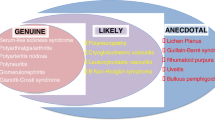Abstract
A 60-year-old man with type-2 diabetes and chronic hepatitis C (HCV) was diagnosed with single hepatocellular carcinoma (HCC) of 67 mm in the hepatic posterior right lobe. Lenvatinib 8 mg was initiated but discontinued because of grade 3 liver injury. The patient continued to have prolonged liver injury and persistently high immunoglobulin G levels. Antinuclear antibody titer increased from 1:40 to 1:320. Histopathological examination of a liver biopsy specimen revealed interface hepatitis with lymphocyte and plasma cell infiltration, rosette formation, and emperipolesis, suggesting the possibility of autoimmune hepatitis (AIH). First, treatment with prednisolone was initiated; however, the response was poor. After starting glecaprevir/pibrentasvir (GLE/PIB) as direct-acting antivirals (DAA), HCV RNA rapidly disappeared, and serological liver function improved. After confirmation of sustained virological response 24, HCC recurrence was observed, and partial hepatectomy was performed. Background liver findings showed that liver parenchymal inflammation improved compared with that before DAA treatment. This is the first case of HCV-AIH overlap syndrome treated with DAA using GLE/PIB. Liver function improved within a short treatment period of 8 weeks, as confirmed using serology and histology.




Similar content being viewed by others
References
Kiyosawa K, Sodeyama T, Tanaka E, et al. Interrelationship of blood transfusion, non-A, non-B hepatitis and hepatocellular carcinoma: analysis by detection of antibody to hepatitis C virus. Hepatology. 1990;12:671–5.
Rigopoulou EI, Zachou K, Gatselis N, et al. Autoimmune hepatitis in patients with chronic HBV and HCV infections: patterns of clinical characteristics, disease progression and outcome. Ann Hepatol. 2013;13:127–35.
Czaja AJ. The variant forms of autoimmune hepatitis. Ann Intern Med. 1996;125:588–98.
Kogure T, Ueno Y, Fukushima K, et al. Fulminant hepatic failure in a case of autoimmune hepatitis in hepatitis C during peg-interferonalpha 2b plus ribavirin treatment. World J Gastroenterol. 2007;13:4394–7.
Sezaki H, Arase Y, Tsubota A, et al. Type C-chronic hepatitis patients who had autoimmune phenomenon and developed jaundice during interferon therapy. J Gastroenterol. 2003;38:493–500.
Calleja JL, Albillos A, Cacho G, Iborra J, Abreu L, Escartín P. Interferon and prednisone therapy in chronic hepatitis C with nonorgan-specific antibodies. J Hepatol. 1996;24:308–12.
Sahebjam F, Hajdu CH, Nortey E, et al. Direct acting antiviral therapy is curative for chronic hepatitis C/autoimmune hepatitis overlap syndrome. World J Hepatol. 2016;8:632–6.
Sugiura A, Wada S, Mori H, et al. Successful treatment for chronic hepatitis C-autoimmune hepatitis overlap syndrome due to daclatasvir and asunaprevir. Case Rep Gastroenterol. 2017;11:305–11.
Putra J, Schiano TD, Fiel MI. Resolution of HCV-autoimmune hepatitis overlap syndrome with antiviral treatment A paired liver biopsy study. Am J Clin Pathol. 2019;152:735–41.
Takikawa H, Onji M. A proposal of the diagnostic scale of drug-induced liver injury. Hepatol Res. 2005;32:250–1.
Chrétien P, Chousterman M, Abd Alsamad I, et al. Non-organ-specific autoantibodies in chronic hepatitis C patients: association with histological activity and fibrosis. J Autoimmun. 2009;32:201–5.
Czaja AJ, Carpenter HA. Histological findings in chronic hepatitis C with autoimmune features. Hepatology. 1997;26:459–66.
European Association for the Study of the Liver. EASL clinical practice guidelines: autoimmune hepatitis. J Hepatol. 2015;63:971–1004.
Bach N, Thung SN, Schaffner F. The histological features of chronic hepatitis C and autoimmune chronic hepatitis: a comparative analysis. Hepatology. 1992;15:572–7.
Simoes CC, Saldarriaga OA, Utay NS, et al. Direct-acting antiviral treatment of patients with hepatitis C resolves serologic and histopathologic features of autoimmune hepatitis. Hepatol Commun. 2019;3:1113–23.
Enomoto M, Ikura Y, Tamori A, et al. Short-term histological evaluations after achieving a sustained virologic response to direct-acting antiviral treatment for chronic hepatitis C. United Eur Gastroenterol J. 2018;6:1391–400.
Miyaki E, Imamura M, Hiraga N, et al. Daclatasvir and asunaprevir treatment improves liver function parameters and reduces liver fibrosis markers in chronic hepatitis C patients. Hepatol Res. 2016;46:756–64.
Bachofner JA, Valli PV, Kröger A, et al. Direct antiviral agent treatment of chronic hepatitis C results in rapid regression of transient elastography and fibrosis markers fibrosis-4 score and aspartate aminotransferase-platelet ratio index. Liver Int. 2017;37:369–76.
Toyofuku T, Hirano K, Ichida T. Clinical significance of M2BPGi measurement in HCV treatment. Jpn J Med Technol. 2017;66:642–8.
Acknowledgements
We would like to thank Editage (http://www.editage.jp) for English language editing.
Author information
Authors and Affiliations
Contributions
All authors contributed to the study conception and design. Material preparation, data collection, and analysis were performed by KM. The first draft of the manuscript was written by KM, KK, and all authors commented on previous versions of the manuscript. All authors read and approved the final manuscript.
Corresponding author
Ethics declarations
Conflict of interest
None of the authors have any conflicts of interest to declare with regards to this report.
Human/animal rights
All procedures followed have been performed in accordance with the ethical standards laid down in the 1964 Declaration of Helsinki and its later amendments.
Informed consent
Informed consent was obtained from the patient of this report.
Additional information
Publisher's Note
Springer Nature remains neutral with regard to jurisdictional claims in published maps and institutional affiliations.
Rights and permissions
Springer Nature or its licensor (e.g. a society or other partner) holds exclusive rights to this article under a publishing agreement with the author(s) or other rightsholder(s); author self-archiving of the accepted manuscript version of this article is solely governed by the terms of such publishing agreement and applicable law.
About this article
Cite this article
Matsumoto, K., Kikuchi, K., Namura, Y. et al. Histological improvement in chronic hepatitis C-autoimmune hepatitis overlap syndrome by glecaprevir and pibrentasvir. Clin J Gastroenterol 16, 572–579 (2023). https://doi.org/10.1007/s12328-023-01809-7
Received:
Accepted:
Published:
Issue Date:
DOI: https://doi.org/10.1007/s12328-023-01809-7




